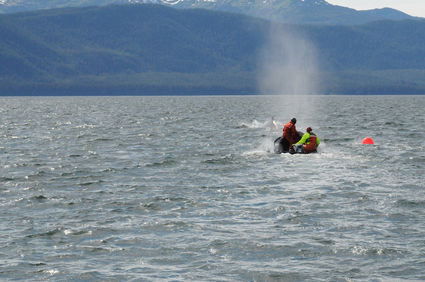Entangled humpback whale still traveling

NOAA Permit 18786 / Submitted Photo
NOAA-led entanglement responders approach and assess the entangled humpback whale near Point Hilda on the west side of Douglas Island in Stephen's Passage.
The NOAA Fisheries Marine Mammal Stranding Network is still tracking the adult, well-traveled humpback whale entangled in line and dragging an orange buoy trailing behind about 30 yards. The network became aware of the entanglement on June 1, and is hoping for the right conditions to untangle the mammal or for it to free itself.
On Sunday, a second sighting in local water resulted in three volunteer members of the Petersburg Marine Mammal Center (PMMC), attempting to untangle the whale. The M/V Catalyst observed the whale in Thomas Bay, and was told not to attempt cutting anything because one wrong cut could make the situation worse.
The vessel maintained sight of the whale and PMMC members Don Holmes, Scott Roberge and Sunny Rice responded. The group caught up with the whale near Farragut Bay, and hopped aboard an inflatable skiff to approach it.
The conditions need to be nearly perfect to allow a team to get close to such a sizable mammal. However, the wind was blowing and the team of three had a hard time keeping up. Holmes said the whale looks to be in good health and described it as "very energetic."
"It was traveling about 5 mph," Holmes said. "The whale is up for about seven, maybe eight seconds, taking a long breath then it's back down. We've never been able to get close to it while it's resting."
Petersburg responders were able to attach a telemetry buoy to the whale, allowing its GPS position to be reliably tracked. The whale shook off a satellite tag placed on June 4 by NOAA-led responders while traveling near Kake.
Holmes credits Roberge for offering his boat to go after the entangled whale and driving the inflatable skiff. Sunny Rice couldn't help but offered a nervous laugh when asked what it's like to get so close to such a large mammal in big water.
"I'm not the best person to ask because I think it's a little scary," Rice said. "It's exciting and when you're successful it is very rewarding. We as a species are the reason why the mammal is entangled so I feel like it's our responsibility to do what we can."
Rice said the training PPMC members receive allows them to assess a situation for the safety of not only crew members, but the mammal as well.
"We want to do what we can for the whale, but our safety is number one," she said.
NOAA Fisheries marine mammal expert Sadie Wright echoes the sentiments about prioritizing safety of crew members in such a delicate and potentially dangerous situation. She also stresses patience.
On Tuesday afternoon, the whale was headed north. A crew, including Wright, was alerted to a sighting close to Juneau that night by a recreational boater.
However, the conditions were, once again, unfavorable and kept the team from attempting to untangle the whale. Wright said the mammal was moving too fast, and a second whale came in close proximity to the entangled whale, and waves were increasing.
According to Wright, as of early Wednesday afternoon, the entangled whale was headed south, again. Tracking data showed it approaching the northern point of Frederick Sound. A couple hours later, the whale changed its mind and was headed toward Seymour Canal. As of press time, after reaching the mouth of the Seymour Canal, the whale headed east about 25 miles toward Windham Bay, according to Holmes.
At this point, two things are certain: the whale is still traveling remarkably well, and it is unknown exactly where the attachment is. The Juneau team and Petersburg responders were hoping to possibly attain an underwater picture of the entanglement.
The footage would help responders better understand the point of entanglement and how to free the whale of it, but conditions made it impossible. Underwater images of entangled whales, while successful in a humpback whale hot spot down south, is proving more difficult in Alaska.
"They use those underwater cameras a lot to access entangled whales in Hawaii, and they are very effective," Wright said. "We have such productive waters here in Southeast Alaska that all the little phytoplankton and what not have been blocking our view."











Reader Comments(0)